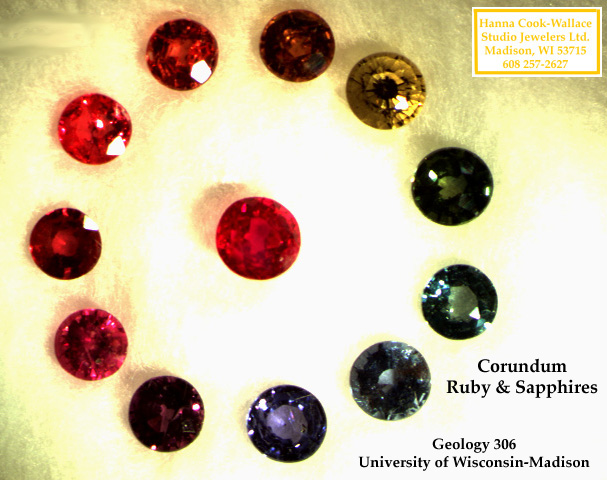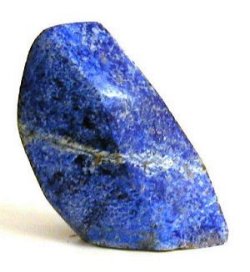
image taken from http://ist-socrates.berkeley.edu/~eps2/wisc/Lect8.html

image taken from http://livingdesigns.co.uk/shop/gemstones/images/g109c01.jpg
Introduction
| Figure 1.1 - The range of colours Corundum can take |
 |
|
image taken from http://ist-socrates.berkeley.edu/~eps2/wisc/Lect8.html |
| Figure 1.2 - An Example of Lapis Lazuli |
|
|
|
image taken from http://livingdesigns.co.uk/shop/gemstones/images/g109c01.jpg |
Sapphires are a variety of the mineral corundum. They are typically thought of as being blue, but they can actually take a wide range of different colours (figure 1.1).
The term 'sapphire' comes from the Greek σάπφειροσ (sappheiros), which means blue, and was historically used to denote opaque blue minerals, particularly lapis lazuli (figure 1.2). More recently, however, the term has been coined for all non-red varieties of corundum, where red corundum is know as ruby.
Pure corundum is crystalline alumina, Al2O3, but this colourless mineral is actually very rare. More often than not, there is trace metal contamination. It is this contamination that distorts the energy levels so that certain wavelengths of light are absorbed, giving rise to the wide ranging colours that can be seen in figure 1.1. To learn more about the colour of the different varieties of Corundum click here.
There are many places in the World that gem grade sapphires are mined, and their appearance and quality tend to vary from place to place. Traditionally, sapphires have been found in Southern Asia. Sri Lanka, Thailand and Burma have been exporting the gems for many centuries, but more recently, deposits in Australia, Africa and America have also been found.
For centuries, Sapphires have been appreciated for they're glittering appearance and it is for this reason that they are widely used in jewellery. It is their rich colour and optical properties that make them so attractive, and as far back as 1240 they have been treated to enhance their colour and clarity. For example, in Sri Lanka, it was found that by heating sapphires in bed of coals, reddish tints would be removed, improving the appearance of the crystals. More recently, it has become possible to make sapphires and rubies from other forms of corundum by adding the trace metal impurities. The methods for this can be seen later.
|
Home ║ Introduction ║ Corundum ║ Colour ║ Synthetic Sapphires ║ Asterias ║ Sapphires of Interest ║ Glossary ║ Links |